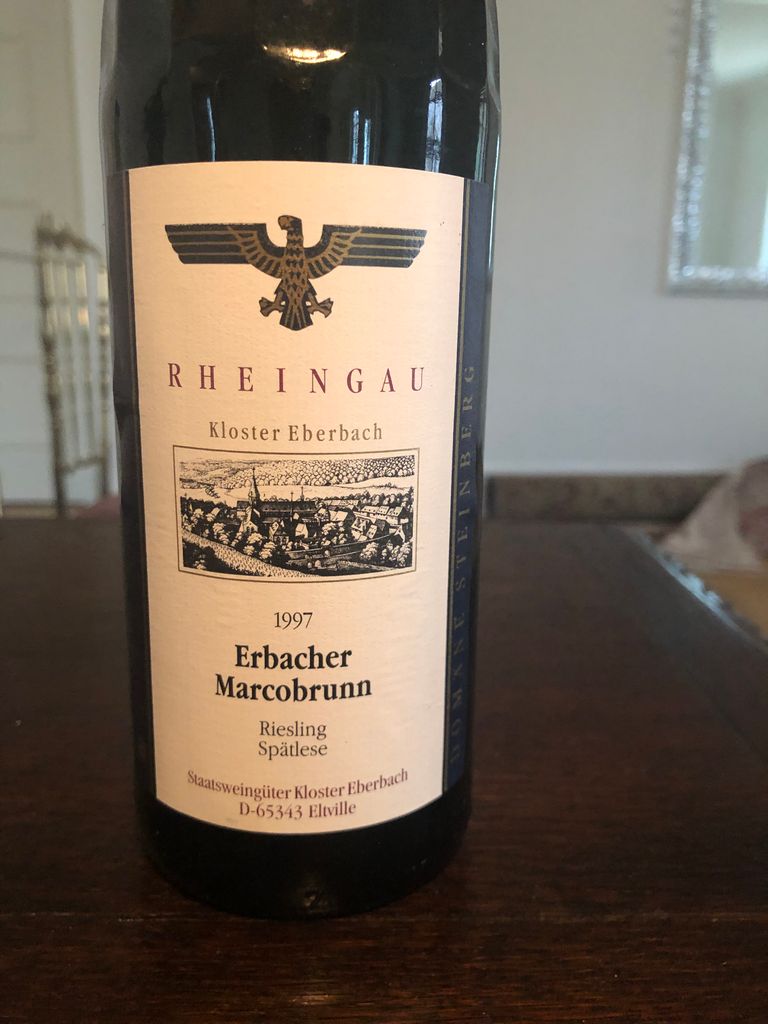
External search
Google (images)
Wine Advocate
Wine Spectator
Burghound
Wine-Searcher
Vintages
2017
2016
2001
2000
1997
1994
1993
1992
1988
1985
1983
1979
1976
1975
1971
From this producer
Show all wines
All tasting notes
|
| Drinking Windows and Values |
| Drinking window: Drink between 2033 and 2048 (based on 7 user opinions) |
| Community Tasting History |
| Hessische Staatsweingüter Kloster Eberbach Producer website
Kloster Eberbach (formal name “Hessische Staatsweingüter Kloster Eberbach”) is a large German wine producer owned by the federal state of Hessen, holding vineyards in the wine regions Rheingau and Hessische Bergstrasse.
Its origins were in the wine operations of the Cistercian monks along the Rhine, centred at the Eberbach monastery (founded 1136).
Their vineyards are divided between three domains and wine cellars: white Rheingau wines at Steinberg (with a new winery from 2008), red Rheingau wines at Assmannshausen and Bergstraße wines at Bergstraße.
The wines are divided between three quality levels:
“Gutsweine” - Basic wines, with grape variety and region designation but no vineyard designation.
“Crescentia” - High-quality, mainly single vineyard wines below the highest (Cabinetkeller) level. Both dry and semi-dry. Classified as Qualitätswein, Kabinett or Spätlese.
“Cabinetkeller” - the best dry and sweet wines of Auslese or higher quality.
Riesling Varietal character (Appellation America) | A short history of Riesling (Uncork) | Riesling (wikipedia)Spätlese Wikipedia article on Spätlese.Erbacher MarcobrunnFromhttp://www.schloss-reinhartshausen.de/static_site/lagen_em.html
The site of “Marcobrunn” has a slightly inclined slope with southern exposure and is located in the district of Erbach. Its name dates back to the 13th century and reminds us of a “Brunnen” (well) situated on the boundaries between Erbach and Hattenheim. The vineyard covers an area of 6.7 ha and is essentially cultivated with Riesling vines which find here the perfect growing conditions.
Here in the Marcobrunn site, the terroir is the source of the quality of its wines. The heavy and deep soils are multi-layered. Loess loam and chalky soil formed of marl and sand provide for excellent nutrients and balance the water supply during dry periods.
The Erbacher Marcobrunn enjoys international acclaim and belongs to the richest and most valuable sites in Germany. Body, power and structure of the wines are in great harmony with the freshness of its minerals and its elegance. They are known to have been appreciated hundreds of years ago by Goethe, Schlegel, Fontane, Jefferson and many more.
German:
Lagenbeschreibung:
Der Marcobrunn liegt in der Gemarkung Erbach 50 Grad in nördlicher Breite, 26 Grad nach dem Meridian von Ferro und enthält an Fläche 8 7/8 Morgen. Die nächste Waldung ist 1200 Klafter entfernt. Südlich stößt er fast an den Rhein. Der Weinberg liegt 210 Pariser Fuß über der Meeresfläche. Die mittlere Temperatur ist 11 Grad Reaumür.
Boden:
Der Boden trägt unverkennbare Spuren von Auflösung. Man findet abwechselnd Letten, die hier und da mit etwas Mergel, schwerem und Lehm wenige Sandadern, auch Traß. Nicht selten zeigen sich die verschiedenen Erdarten schichtweise übereinander und enthalten öfter Wassermuscheln in großer Zahl. Als untermischte Steinadern finden sich Quarz, Wacke, Würfelschiefer, auch eine Granitart. Die meisten solcher Steine, wie auch der Traß sind eisenschüssig. Felsen fanden sich hier nicht, obwohl 6-12 Fuß in die Erdschichte eingeschlagen wurde. Die Steine mögen sich zur Erde verhalten wie 1 zu 10. Der Humus ist nur aus Dung erzeugt, dessen alle 3 Jahre 80 Karn pro Morgen eingebracht werden. Schädlich dürfte der Traß seyn, welcher Metalloxyd enthält.
Geo DataGermany Wines of Germany | The Association of German Prädikat Wine Estates (VDP) | How to read a German wine label | Geographical Information Down to Single Vineyards
#2014 Vintage Notes:
2014 Vintage Report by Terry Theise
2014 Vintage Report by Wine Spectator
"My gut still tells me the Saar (and to some extent) the Ruwer are better overall in 2014 than the more storied areas of the Mosel proper, but those that spent the requisite time living in their middle-Mosel vineyards made some of the most electric and "feathery" Riesling in a long time (maybe the finest in 20 years - yes, it's true!)" - Jon Rimmerman (Of course only a very short historical memory would call the Saar and Ruwer less 'storied' than the middle Mosel - jht)Rheingau VDP Rheingau (Official site) | The Rheingau (Wines of Germany) | Wikipedia about The Rheingau
On weinlagen.info
The small but fine wine-growing area Rheingau offers one for the culture of the vine ideal microclimate and best soil conditions. The Rhine runs uninterruptedly almost one thousand kilometres from Basel up to its muzzle into the North Sea, in a northerly direction. With a short exception - the Rheingau. The Rheingau mountains force the river to a change in direction here. The vineyards falling in this region to the south stretch really to the sun. The king of the white wines, the Riesling, finds ideal local conditions for the unfolding of his fine fruity and elegant type of vine character on the multilayered weathering grounds with loess, loam and sand additions. |
|




